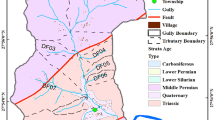Abstract
On August 7 and 8, 2010, a catastrophic debris flow disaster occurred in Zhouqu County in northwestern China’s Gansu Province. The large-scale debris flow event destroyed more than 200 buildings, killing approximately 1,700 people. Field investigations showed that the debris flow disaster was not only a natural hazard but also anthropogenic. First, the partial implemented check dams had not formed an integral blocking system to resist large events. Second, poor-quality workmanship contributed to the breakage of check dams. Third, disorderly placement of houses and buildings on the fan structure rendered the cross-sectional area of drainage channel too small to accommodate such a large event. The lessons learned from these hazards may be valuable for improving protective measures against these types of very large debris flow events in northwestern China in the future.











Similar content being viewed by others
References
Bai SB, Wang J, Zhang ZG, Cheng C (2012) Combined landslide susceptibility mapping after Wenchuan earthquake at the Zhouqu segment in the Bailongjiang Basin, China. Catena 99:18–25
Chanson H (2004) Sabo check dams—mountain protection systems in Japan. J River Basin Manag 2(4):301–307
Chen H, Lee CF (2000) Numerical simulation of debris flows. Can Geotech J 37:146–160
Chen H, Lee CF (2003) A dynamic model for rainfall-induced landslides on natural slopes. Geomorphology 51:269–288
Clague JJ, Evans SG, Blown IG (1985) A debris flow triggered by the breaching of a moraine-dammed lake, Klattasine Greek. J Earth Sci 22(10):1492–1502
Dijkstra TA, Chandler J, Wackrow R, Meng XM, Ma DT, Gibson A, Whitworth M, Foster C, Lee K, Hobbs PRN, Reeves HJ, Wasowski J (2012) Geomorphic controls and debris flows—the 2010 Zhouqu disaster, China. Proceedings of the 11th international symposium on landslides (ISL) and the 2nd North American Symposium on Landslides, June 2–8, 2012, Banff, Alberta, Canada
Hungr O, Morgan GC, Kellerhals R (1984) Quantitative analysis of debris torrent hazards for design of remedial measures. Can Geotech J 21:663–677
Hürlimann M, Copons R, Altimir J (2006) Detailed debris flow hazard assessment in Andorra, a multidisciplinary approach. Geomorphology 78:359–372
Itasca (2005) UDEC—Universal Distinct Element Code (Version 4.0). Itasca Consulting Group, Inc., Minneapolis
Jakob M (2005) Debris-flow hazard analysis. In: Jakob M, Hungr O (eds) Debris-flow hazards and related phenomena. Praxis-Springer, Berlin, pp 411–443
Kanji MA, Cruz PT, Massad F (2008) Debris flow affecting the Cubatao oil refinery. Landslides 5(1):71–82
Li ZH, Wu H, Ma DT, Qi L, Gao SY, You GX, Cai XY, Shi DT, Li AD (1997) The preliminary design report for control of the Sanyanyu debris flow in Zhouqu county, China (in Chinese) Edited by northwest branch of exploration and design institute of geological hazard control engineering
Li RD, Ma ZY, Hu XD (2011) Limit analysis of blocking structure of pile group for Zhouqu debris flow. Gansu Geol 20(2):60–65 (in Chinese)
Ma DT (2010) Some suggestions on controlling catastrophic debris flows on Aug. 8th, 2010 in Zhouqu, Gansu. J Mt Sci 28(5):635–640 (in Chinese)
Ma DT, Qi L (1997) Study on comprehensive controlling of debris flow hazards in Sanyanyu Gully. Bull Soil Water Conserv 17(4):26–31 (in Chinese)
Scheidegger AE, Ai NS (1987) Clay slides and debris flow in Wudu region. J Soil Water Conserv 1(2):19–27
Schuster RL, Salcedo DA, Valenzuela L (2002) Overview of catastrophic landslides of South America in the twentieth century. In: Evans SG, DeGraff JV (eds) Catastrophic landslides: effects, occurrence, and mechanisms. Geological Society of America, Boulder, pp 1–34
Shieh CL, Jan CD, Tsai YF (1996) A numerical simulation of debris flow and its application. Nat Hazards 13:39–54
Takahashi T (1981) Estimation of potential debris flows and their hazardous zones. J Nat Disaster Sci 3(1):57–89
Tang C, Zhu J, Li WL (2009) Rainfall triggered debris flows after Wenchuan earthquake. Bull Eng Geol Environ 68:187–194
Tang C, Rengers N, van Asch ThWJ, Yang YH, Wang GF (2011) Triggering conditions and depositional characteristics of a disastrous debris flow event in Zhouqu city, Gansu Province northwestern China. Nat Hazards Earth Syst Sci 11:2903–2912
Varnes DJ (1978) Slope movement types and processes. In: Schuster RL, Krizek RJ (eds) Landslides analysis and control. Transportation Research Board Special Report, vol 176. National Research Council, Washington, pp 11–33
Wang D, Meng XM (eds) (2009) Field guide book. Lanzhou University internal publication
Xiao HJ, Luo ZD, Niu QG, Chang J (2013) The 2010 Zhouqu mudflow disaster: possible causes, human contributions, and lessons learned. Nat Hazards 67:611–625
Yu B, Yang YH, Su YC, Huang WJ, Wang GF (2010) Research on the giant debris flow hazards in Zhouqu County, Gansu Province on August 7, 2010. J Eng Geol 18(4):437–444 (in Chinese)
Zeng QL, Yue ZQ, Yang ZF, Zhang XJ (2009) A case study of long-term field performance of check-dams in mitigation of soil erosion in Jiangjia stream, China. Environ Geol 58:897–911
Zhang S (1993) A comprehensive approach to the observation and prevention of debris flows in China. Nat Hazards 7:1–23
Acknowledgments
This work was funded by the China Geological Survey and the Key Laboratory of Geo-hazards in the Loess Area. The author would like to thank M. S. Zhang, Z. H. Li, and G. Q. Yu and two anonymous reviewers for their valuable comments on an earlier draft of this paper.
Author information
Authors and Affiliations
Corresponding author
Rights and permissions
About this article
Cite this article
Wang, G.L. Lessons learned from protective measures associated with the 2010 Zhouqu debris flow disaster in China. Nat Hazards 69, 1835–1847 (2013). https://doi.org/10.1007/s11069-013-0772-1
Received:
Accepted:
Published:
Issue Date:
DOI: https://doi.org/10.1007/s11069-013-0772-1




